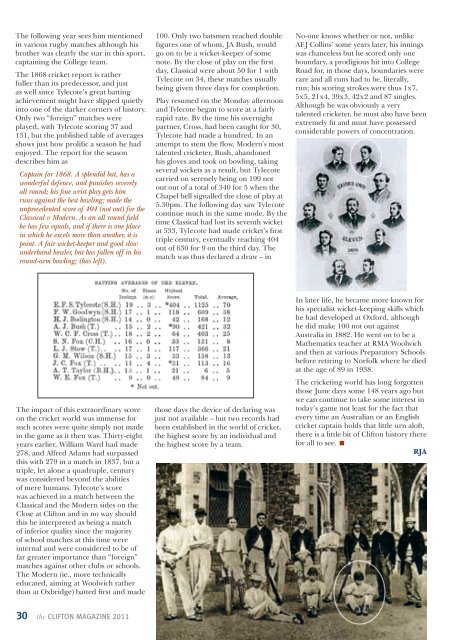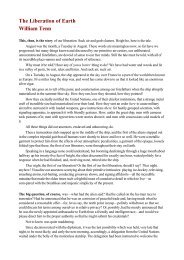Old_Cliftonian_Mag_2011
Old_Cliftonian_Mag_2011
Old_Cliftonian_Mag_2011
You also want an ePaper? Increase the reach of your titles
YUMPU automatically turns print PDFs into web optimized ePapers that Google loves.
The following year sees him mentioned<br />
in various rugby matches although his<br />
brother was clearly the star in this sport,<br />
captaining the College team.<br />
The 1868 cricket report is rather<br />
fuller than its predecessor, and just<br />
as well since Tylecote’s great batting<br />
achievement might have slipped quietly<br />
into one of the darker corners of history.<br />
Only two “foreign” matches were<br />
played, with Tylecote scoring 37 and<br />
131, but the published table of averages<br />
shows just how prolific a season he had<br />
enjoyed. The report for the season<br />
describes him as<br />
Captain for 1868. A splendid bat, has a<br />
wonderful defence, and punishes severely<br />
all round; his fine wrist play gets him<br />
runs against the best bowling; made the<br />
unprecedented score of 404 (not out) for the<br />
Classical v Modern. As an all round field<br />
he has few equals, and if there is one place<br />
in which he excels more than another, it is<br />
point. A fair wicket-keeper and good slow<br />
underhand bowler, but has fallen off in his<br />
round-arm bowling; (has left).<br />
100. Only two batsmen reached double<br />
figures one of whom, JA Bush, would<br />
go on to be a wicket-keeper of some<br />
note. By the close of play on the first<br />
day, Classical were about 50 for 1 with<br />
Tylecote on 34, these matches usually<br />
being given three days for completion.<br />
Play resumed on the Monday afternoon<br />
andTylecote began to score at a fairly<br />
rapid rate. By the time his overnight<br />
partner, Cross, had been caught for 30,<br />
Tylecote had made a hundred. In an<br />
attempt to stem the flow, Modern’s most<br />
talented cricketer, Bush, abandoned<br />
his gloves and took on bowling, taking<br />
several wickets as a result, but Tylecote<br />
carried on serenely being on 199 not<br />
out out of a total of 340 for 5 when the<br />
Chapel bell signalled the close of play at<br />
5.30pm. The following day saw Tylecote<br />
continue much in the same mode. By the<br />
time Classical had lost its seventh wicket<br />
at 533, Tylecote had made cricket’s first<br />
triple century, eventually reaching 404<br />
out of 630 for 9 on the third day. The<br />
match was thus declared a draw – in<br />
No-one knows whether or not, unlike<br />
AEJ Collins’ some years later, his innings<br />
was chanceless but he scored only one<br />
boundary, a prodigious hit into College<br />
Road for, in those days, boundaries were<br />
rare and all runs had to be, literally,<br />
run; his scoring strokes were thus 1x7,<br />
5x5, 21x4, 39x3, 42x2 and 87 singles.<br />
Although he was obviously a very<br />
talented cricketer, he must also have been<br />
extremely fit and must have possessed<br />
considerable powers of concentration.<br />
The impact of this extraordinary score<br />
on the cricket world was immense for<br />
such scores were quite simply not made<br />
in the game as it then was. Thirty-eight<br />
years earlier, William Ward had made<br />
278, and Alfred Adams had surpassed<br />
this with 279 in a match in 1837, but a<br />
triple, let alone a quadruple, century<br />
was considered beyond the abilities<br />
of mere humans. Tylecote’s score<br />
was achieved in a match between the<br />
Classical and the Modern sides on the<br />
Close at Clifton and in no way should<br />
this be interpreted as being a match<br />
of inferior quality since the majority<br />
of school matches at this time were<br />
internal and were considered to be of<br />
far greater importance than “foreign”<br />
matches against other clubs or schools.<br />
The Modern (ie., more technically<br />
educated, aiming at Woolwich rather<br />
than at Oxbridge) batted first and made<br />
those days the device of declaring was<br />
just not available – but two records had<br />
been established in the world of cricket,<br />
the highest score by an individual and<br />
the highest score by a team.<br />
In later life, he became more known for<br />
his specialist wicket-keeping skills which<br />
he had developed at Oxford, although<br />
he did make 100 not out against<br />
Australia in 1882. He went on to be a<br />
Mathematics teacher at RMA Woolwich<br />
and then at various Preparatory Schools<br />
before retiring to Norfolk where he died<br />
at the age of 89 in 1938.<br />
The cricketing world has long forgotten<br />
those June days some 148 years ago but<br />
we can continue to take some interest in<br />
today’s game not least for the fact that<br />
every time an Australian or an English<br />
cricket captain holds that little urn aloft,<br />
there is a little bit of Clifton history there<br />
for all to see.<br />
RJA<br />
30 the CLIFTON MAGAZINE <strong>2011</strong>



